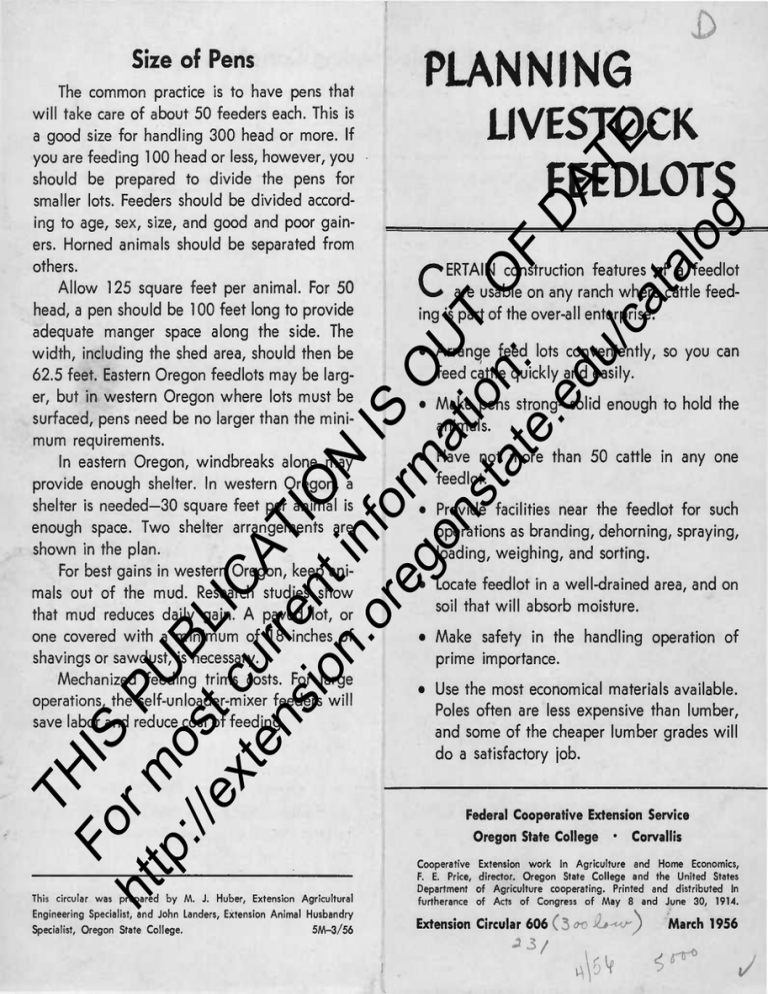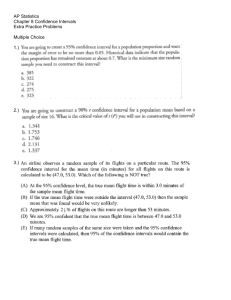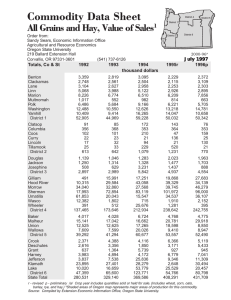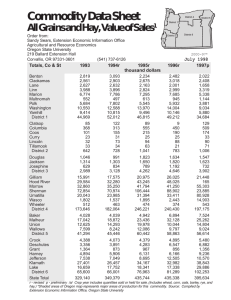PLANNING LIVESTOCK Size of Pens
advertisement

Size of Pens PLANNING LIVESTOCK FEEDLOTS TH Fo IS ht r m P U tp :// os BL ex t c IC te ur A ns re TI io nt ON n. in or fo IS eg rm O on at U st ion T O at : F e. D ed A u/ TE ca . ta lo g The common practice is to have pens that will take care of about 50 feeders each. This is a good size for handling 300 head or more. If you are feeding 100 head or less, however, you should be prepared to divide the pens for smaller lots. Feeders should be divided according to age, sex, size, and good and poor gainers. Horned animals should be separated from others. Allow 125 square feet per animal. For 50 head, a pen should be 100 feet long to provide adequate manger space along the side. The width, including the shed area, should then be 62.5 feet. Eastern Oregon feedlots may be larger, but in western Oregon where lots must be surfaced, pens need be no larger than the minimum requirements. In eastern Oregon, windbreaks alone may provide enough shelter. In western Oregon, a shelter is needed—30 square feet per animal is enough space. Two shelter arrangements are shown in the plan. For best gains in western Oregon, keep animals out of the mud. Research studies show that mud reduces daily gain. A paved lot, or one covered with a minimum of 18 inches of shavings or sawdust, is necessary. Mechanized feeding trims costs. For large operations, the self-unloader-mixer feeders will save labor and reduce cost of feeding. CERTAIN construction features of a feed lot are usable on any ranch where cattle feeding is part of the over-all enterprise. • Arrange feed lots conveniently, so you can feed cattle quickly and easily. • Make pens strong—solid enough to hold the animals. • Have not more than 50 cattle in any one feedlot. • Provide facilities near the feedlot for such operations as branding, dehorning, spraying, loading, weighing, and sorting. • Locate feedlot in a well-drained area, and on soil that will absorb moisture. • Make safety in the handling operation of prime importance. • Use the most economical materials available. Poles often are less expensive than lumber, and some of the cheaper lumber grades will do a satisfactory job. Federal Cooperative Extension Service Oregon State College This circular was prepared by M. J. Huber, Extension Agricultural Engineering Specialist, and John Landers, Extension Animal Husbandry Specialist, Oregon State College. 5M-3/56 Cooperative F. E. Price, Department furtherance ■ Corvallis Extension work in Agriculture and Home Economics, director. Oregon State College and the United States of Agriculture cooperating. Printed and distributed in of Acts of Congress of May 8 and June 30, 1914. Extension Circular 606 Joe iLt~«r -) ^ March 1956 ^ t/ Plan of Cattle Feeding Corrals 2&0 Fo IS ht r m P U tp :// os BL ex t c IC te ur A ns re TI io nt ON n. in or fo IS eg rm O on at U st ion T O at : F e. D ed A u/ TE ca . ta lo g . feo SHELTEK j 20' V IS' SHELTER O 20' X ?&' I 1 1 _A_ I 75 75 ■H SQUEEZE . ^HEAO '•A GATE 5X *o' o' mil mill to' I, MflN&EKS GRAVEL OR PAVED FEED ALLEY CO to' i V0 SHELTER 20 X 75 'VI Layout of Pens TH Lay out the pens for convenience in feeding and handling. It is necessary to move animals from one pen to another—for weighing, sorting, and shipping. A suggested layout of 4 pens plus a corral is shown above. This plan can be expanded to fit any size operation. If hay is the only roughage, it may be fed in the mangers shown, but the mangers should be designed for hay feeding. When hay and ensilage are fed, the hay bunks may be made along the center fence dividing the pens. You can make a slatted hay rack above the ensilage mangers, but more hay will be wasted. In eastern Oregon, where shelters are not commonly used, it is a good practice before fencing the corrals to build a mound of dirt 1 V2 feet to 2 feet high in the center of the corral. The mound provides a dry place for animals to lie. Shavings or sawdust may be substituted for dirt.






